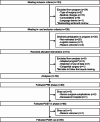Feasibility of preoperative and postoperative physical rehabilitation for cardiac surgery patients - a longitudinal cohort study
- PMID: 38115103
- PMCID: PMC10731823
- DOI: 10.1186/s13102-023-00786-1
Feasibility of preoperative and postoperative physical rehabilitation for cardiac surgery patients - a longitudinal cohort study
Abstract
Background: This study aimed to determine the feasibility of a preoperative and postoperative (in- and outpatient) physical rehabilitation program, the Heart-ROCQ-pilot program.
Methods: This cohort study included patients undergoing cardiac surgery (including coronary artery bypass graft surgery, valve surgery, aortic surgery, or combinations of these surgeries) and participated in the Heart-ROCQ-pilot program. Feasibility involved compliance and characteristics of bicycle and strength training sessions in the three rehabilitation phases.
Results: Of the eligible patients, 56% (n = 74) participated in the program (41% of exclusions were due to various health reasons). On average across the rehabilitation phases, the compliance rates of bicycle and strength training were 88% and 83%, respectively. Workload to heart rate (W/HR) ratio and total absolute volume load for bicycle and strength training, respectively, improved in each rehabilitation phase (P < 0.05). The W/HR-ratio was higher during the last postoperative session compared to the first preoperative session (0.48 to 0.63 W/beat, P < 0.001) and similar to the last preoperative session (0.65 to 0.64 W/beat, P < 0.497). During less than 1% of the bicycle sessions, patients reported discomfort scores of 5 to 6 (scale 0-10, with higher scores indicating a higher level).
Conclusions: The Heart-ROCQ-pilot program was feasible for patients awaiting cardiac surgery. Patients were very compliant and were able to safely increase the training load before surgery and regained this improvement within eight weeks after surgery.
Keywords: Cardiac surgical procedures; Coronary artery Disease; Endurance training; Ergometry; Observational study; Preoperative exercise; Therapeutics.
© 2023. The Author(s).
Conflict of interest statement
SD, JH, and MAM report grants from “Stichting Beatrixoord Noord-Nederland”, Edwards Lifesciences SA, and Abbott (formerly St. Jude Medical Nederland B.V.). MAM reports consultancy from AtriCure, Getinge, and LivaNova. The remaining authors have nothing to disclose.
Figures





Similar articles
-
Factors affecting adherence to physical training in the outpatient phase of rehabilitation, in patients after coronary artery bypass grafting.Kardiologiia. 2022 Jun 30;62(6):37-44. doi: 10.18087/cardio.2022.6.n1756. Kardiologiia. 2022. PMID: 35834340 Clinical Trial. English, Russian.
-
Home-based preoperative rehabilitation (prehab) to improve physical function and reduce hospital length of stay for frail patients undergoing coronary artery bypass graft and valve surgery.J Cardiothorac Surg. 2017 Oct 26;12(1):91. doi: 10.1186/s13019-017-0655-8. J Cardiothorac Surg. 2017. PMID: 29073924 Free PMC article.
-
[Improvement of physical performance and aerobic capacity mediated by a novel 4--week ambulatory cardiac rehabilitation program].Z Kardiol. 1999 Feb;88(2):113-22. doi: 10.1007/s003920050267. Z Kardiol. 1999. PMID: 10209832 German.
-
Feasibility of physical training after myocardial infarction and its effect on return to work, morbidity and mortality.Acta Med Scand Suppl. 1976;599:7-84. Acta Med Scand Suppl. 1976. PMID: 16981325 Review.
-
Effectiveness of nurse-led cardiac rehabilitation programs following coronary artery bypass graft surgery: a systematic review.JBI Database System Rev Implement Rep. 2018 Dec;16(12):2304-2329. doi: 10.11124/JBISRIR-2017-003565. JBI Database System Rev Implement Rep. 2018. PMID: 30204710
Cited by
-
Exercise rehabilitation for patients undergoing interventional treatment for heart valve disease: a scoping review and evidence summary.BMC Nurs. 2025 Jul 21;24(1):950. doi: 10.1186/s12912-025-03603-x. BMC Nurs. 2025. PMID: 40691588 Free PMC article.
References
-
- Ruiz-Núñez B, Pruimboom L, Dijck-Brouwer DAJ, Muskiet FAJ. Lifestyle and nutritional imbalances associated with western Diseases: causes and consequences of chronic systemic low-grade inflammation in an evolutionary context. J Nutr Biochem. 2013;24:1183–201. doi: 10.1016/j.jnutbio.2013.02.009. - DOI - PubMed
-
- Arthur HM, Daniels C, McKelvie R, Hirsh J, Rush B. Effect of a preoperative intervention on preoperative and postoperative outcomes in low-risk patients awaiting elective coronary artery bypass graft Surgery: a randomized, controlled trial. Ann Intern Med. 2000;133:253–62. doi: 10.7326/0003-4819-133-4-200008150-00007. - DOI - PubMed
Grants and funding
LinkOut - more resources
Full Text Sources

